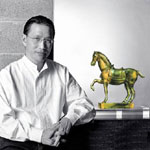|
Man of glass
By Xu Wei (China Daily)
Updated: 2004-12-22 10:43

Taiwanese glass artist Heinrich Wang and his exquisite glasswork, which is displayed in Shanghai as part of his Asian tour. |
Moving China to the forefront of international glass and crystal art design is the ambition of a renowned Taiwanese artist who has arrived in Shanghai with a touring exhibition of his works.
The exquisitely designed glass and crystal art of 51-year-old Heinrich Wang are a mirror to the deep influence of Chinese culture through their Oriental motifs and elements. Wang, the "father" of all the inspiring works to go on display says: "Glass is ubiquitous in our lives. But people have become so used to its existence and presence that they take little notice of its beauty. What I'm trying to do is to share its unique charm with everyone." Wang is bringing 50 of his classic works to Shanghai - the fourth stop on his touring solo exhibition around Asia. Previous shows since the tour began last July have been in Tokyo, Beijing and Hong Kong. The exhibits include "Landscape" series, some Buddhist statues and some lovely pieces depicting the rooster - one of the 12 creatures of the Chinese zodiac and the coming lunar New Year.
However, the highlight of the exhibition is his great "Landscape" series which has taken some five years in conception and creation. "Descriptions of landscapes with Chinese plants and stonework were always a favorite of ancient poets and writers of literature," Wang says. "But this time people will have a brand-new feeling about the subject when they see transparent glass-made landscapes."
Thanks to its unique depiction of Chinese culture, the "Landscape" series has been chosen to go on exhibition next March in the Louvre in Paris, the national art museum of France. Wang now works as art director for the world-renowned Tittot company, an elite creator of glass and crystal artworks for names such as Baccarat, Swarovski, Lalique, Daum and Waterford.
The harmonious combination of Chinese cultural elements with modern Western technology achieved by Tittot has attracted many famous museums around the world to buy its fine glass and crystal works for their permanent displays. In autumn 1993, five crystal artworks by Wang went into the permanent collection of the Palace Museum in Beijing. In 1994, Wang held a solo exhibition entitled, "In the Depths of the Courtyard," at the Habatat Galleries, one of the leading galleries focusing on contemporary glass art in the United States. This was the first time that modern Chinese glass art had been displayed by a prominent international gallery. In 2002, Wang's creations earned the honor of being the first Chinese crystal artworks displayed in Frankfurt Messe's permanent collection. Wang's artistic career hasn't always been in glass.
He worked as a film director, actor, advertising designer before his discovery of glass art 17 years ago. "In 1987, my passion for glass was inspired by an exquisite French paperweight on which an Indian ox was vividly engraved," Wang recalls "Glass is such a marvelous material on which 17 different technologies can be applied. Because of its sensitivity to light, artists can make a strong visual impact." Wang made up his mind to pursue a career in glass art. After studies at the Detroit Creative Institute in the United States, he founded Taiwan's first glass art studio before joining the Tittot company. His former experience in other artistic fields has played an important role in his new career. "I have learned patience, perseverance and the pursuit of perfection from my time as a film director," Wang says. "Glass is so fragile at high temperatures and easy to crack. Actually I have also tasted many failures." In his artworks, the lost wax method is usually used although it is recognized as the most complicated glass-making technique.
However, Wang has never hesitated to take the challenge presented by the limits imposed when working with glass. "This labor-consuming technique requires more than 40 manual operations to ensure the delicacy and brilliance of crystal," Wang says. "But it allows for maximum creative freedom and is more apt to capture the essence of magnificence of Chinese culture." Glass was first discovered in 2500 BC and glass blowing was invented by the Romans circa 100 AD. The industrial revolution in Europe in the 19th century made glass a mass-produced commodity and glass art enjoyed a revival towards the end of that century. "The studio glass movement in the 1960s in the United States transformed glass from a utilitarian material into a medium of artistic creativity," Wang says.
"But for a long time no Chinese attempted to use glass as a modern artistic medium. Chinese glass artists seem to have been absent from the international stage for long." To pass on his knowledge of creating brilliant glass artworks with a Chinese flavor, Wang has opened the 10,000-square-meter Tittot Glass Museum in Taiwan to display the latest glasswork. "In the near future, I will open more Tittot outlets and glass museums on the Chinese mainland to promote the charm of glass art to the public," he says. Heinrich Wang's glasswork show
Date: December 22-January 4 (closed on Mondays), 10am-6pm
Venue: Shanghai Duolun Museum of Modern Art, 27 Duolun Rd
Admission: 15 yuan
Tel: 6587-2530
|
